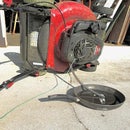Introduction: Concentric Drilling With a Radial Arm Saw
This is a piece of round stock into which I have drilled a hole that is perfectly on center. I could have made the hole as deep as my drill bit is long, but left it shallow. I did this on my radial arm saw. What I am demonstrating in this Instructable was inspired by a chapter in the Foxfire Books on boring the barrel for a Kentucky flintlock rifle.
Step 1: Features of a Radial Arm Saw
My radial arm saw has a 1/2 x 20 threaded shaft on the backside of the motor. Not only can I attach a saw blade on the front side of the motor, but I can attach a drill chuck or a sanding drum on the backside end. Further, I can swivel the motor so the shaft runs parallel to the saw arm. Because the motor moves along the arm on a suspension track, I can pull the motor into something I want to drill. That would move the motor and bit nearer to the left side of the photo.
I cut a piece of wood 2 x 3 inches a little over 5 inches long and aligned it under the drill bit so it is parallel to the drill bit.
I cut a piece of wood 2 x 3 inches a little over 5 inches long and aligned it under the drill bit so it is parallel to the drill bit.
Step 2: Make an Upright
I cut two pieces of 1/2 inch plywood and attached the first one to the piece of 2 x 3 with drywall screws. You may notice the bit in the chuck is very small in this photo. This is the size I would use to make a pilot hole if I were using a brace with an expansion bit. The small pilot hole marks the center of the drill chuck and also allows the screw threads on the expansion bit to grab the wood and pull the bit through for cutting the hole.
The time I needed to use what I am demonstrating here I had only the expansion bit. I needed to drill a concentric hole 1/2 inch in diameter up the end of a nicely finished banner pole so it could rest on a fancy brass stand with a vertical 1/2 inch steel rod bolted into its center. Neither the hole nor the steel rod would be visible when in use.
The time I needed to use what I am demonstrating here I had only the expansion bit. I needed to drill a concentric hole 1/2 inch in diameter up the end of a nicely finished banner pole so it could rest on a fancy brass stand with a vertical 1/2 inch steel rod bolted into its center. Neither the hole nor the steel rod would be visible when in use.
Step 3: Clamp and Drill
Use a large "C" clamp to hold the 2 x 3 firmly to the saw table. Pull the saw motor into the upright so the drill bit makes a pilot hole on center with the drill chuck.
Step 4: Or, Use Another Pilot Bit
I now have a hole saw the same diameter as the piece of round stock in the first photo. Its pilot drill is 1/4 inch in diameter. I have placed a 1/4 inch drill into the chuck. And will enlarge the pilot hole in the previous step to 1/4 inch.
Step 5: Make a Second Upright
The second upright is like the first, but mounts to the end of the 2 x 3 inch piece nearer to the saw motor. One feature of a radial arm saw is that the arm can be swung to the side to make room, and then put back into the same precise indexed position. Swing the saw arm back into position and make a pilot hole in the second upright.
Step 6: Make the First Hole Larger With the Hole Saw
My saw's shaft turns at about 3,000 rpm. That is too fast for my hole saw. I used the pilot hole to center the hole saw mounted in my electric drill.
Step 7: Enlarge the Other Hole
Move the saw's arm to one side to make room and use the hole saw to enlarge the second hole. When finished I had two holes the same size as the round stockand on the same center as the drill chuck.
Step 8: Insert the Round Stock and Drill
The round stock has been inserted through the holes in the support. Push the drill bit and the round stock into one another. Because my motor turns at 3,000 rpm, I drill in very short bursts to keep the bit from overheating. Some radial arm saws have a 1/2 x 20 spindle that runs at a greatly reduced speed and is helpful for drilling operations.
The jig for this operation is specific to the size of the round stock used. It would be difficult to remove the jig and attach it again later. Too many things would have moved and the holes in the uprights would no longer be concentric with the drill bit. But, it is very useful when you have a specific need for a concentric hole in a longer piece of round stock.
The jig for this operation is specific to the size of the round stock used. It would be difficult to remove the jig and attach it again later. Too many things would have moved and the holes in the uprights would no longer be concentric with the drill bit. But, it is very useful when you have a specific need for a concentric hole in a longer piece of round stock.











